Overview of the Global Anemia Problem, Including Iron Deficiency Anemia
The World Health Organization (WHO) defines anemia among women of childbearing age as the condition of having a hemoglobin concentration of < 12.0 g/dL at sea level; among pregnant women it is defined as < 11.0 g/dL. The hemoglobin concentration cutoff level that defines anemia varies by age, gender, physiological status, smoking status, and the altitude at which the assessed population lives.
The primary cause of anemia is iron deficiency, a condition caused by inadequate intake or low absorption of iron, the increased demands of repeated pregnancies—particularly if not well spaced (e.g., fewer than 36 months between pregnancies)—and loss of iron through menstruation. Other causes of anemia include vitamin deficiencies (such as a deficiency of folic acid or vitamin A), genetic disorders, malaria, parasitic infections, HIV, tuberculosis, common infections, and other inflammatory conditions. While iron deficiency anemia (IDA) accounts for about one-half of all anemia cases, it often coexists with these other causes.
Iron deficiency anemia is most common during pregnancy and in infancy, when physiological iron requirements are the highest and the amount of iron absorbed from the diet is not sufficient to meet many individuals’ requirements (Stoltzfus and Dreyfuss 1998). Anemia’s effects include increased risk of premature delivery, increased risk of maternal and child mortality, negative impacts on the cognitive and physical development of children, and reduced physical stamina and productivity of people of all ages (Horton and Ross 2003). Globally, IDA annually contributes to over 100,000 maternal deaths (22 percent of all maternal deaths) and over 600,000 perinatal deaths (Stoltzfus, Mullany, and Black 2004). Key anemia control interventions include promoting a diversified diet, iron-folic acid (IFA) supplementation during pregnancy, iron fortification of staple foods, prevention and treatment of malaria, use of insecticide-treated bed nets, helminth prevention and control, delayed cord clamping, and increased birth spacing.
Maternal Anemia in the Philippines
According the most recent national Philippines data (now 11 years old), 43.9 percent of pregnant women suffer from anemia, making it a severe public health problem as defined by WHO standards1 (FNRI 2004). Among the sixteen regions in the Philippines, Bicol Region and Zamboanga Peninsula (formerly Western Mindanao) have the highest anemia rates among pregnant (64 percent) and breastfeeding women (72 percent) (Cheong et al. 2001). A study on the iron status of pregnant women in the mountain, coastal, and city regions of Zamboanga del Sur province in Zamboanga Peninsula found that at 24 weeks gestation, 34 percent of women were anemic using the second trimester specific hemoglobin cut-off value of 10.5 grams/deciliter (de Jong, Romano, and Gibson 2002). However, the prevalence of anemia increased to 51 percent when the WHO cut-off for anemia among pregnant women (hemoglobin 11.0 grams/deciliter), not accounting for trimester, was applied.
Falter Points in Women's Consumption of Iron-Folic Acid During Pregnancy
WHO recommends that all pregnant women receive a standard dose of 30–60 mg iron and 400 μg folic acid beginning as soon as possible during gestation (WHO 2012a). Ideally, women should receive iron-containing supplements no later than the first trimester of pregnancy, which means ideally taking 180 tablets before delivery. It is important to note, that many countries aim for women to receive 90 or more tablets during pregnancy.
Figure 1 on the following page shows a decision-tree analysis of how well the Philippine antenatal care (ANC) system distributes IFA, and identifies four potential points at which the system might falter (highlighted in orange). The figure tracks the number and percentage of women who obtained ANC, those who subsequently received and consumed at least one IFA tablet, and those who consumed the ideal minimum number of tablets.2 All data are based on the Philippines Demographic and Health Survey (PDHS) questions that were asked of women who were in a permanent union and had been pregnant in the five years prior to being interviewed3 (NSO and ICF Macro 2009).
Figure 1. Analysis of Falter Points Related to Distribution and Consumption of IFA through Philippines’ ANC Program in 2008, Women of Reproductive Age (15–49 years) n = 13,594
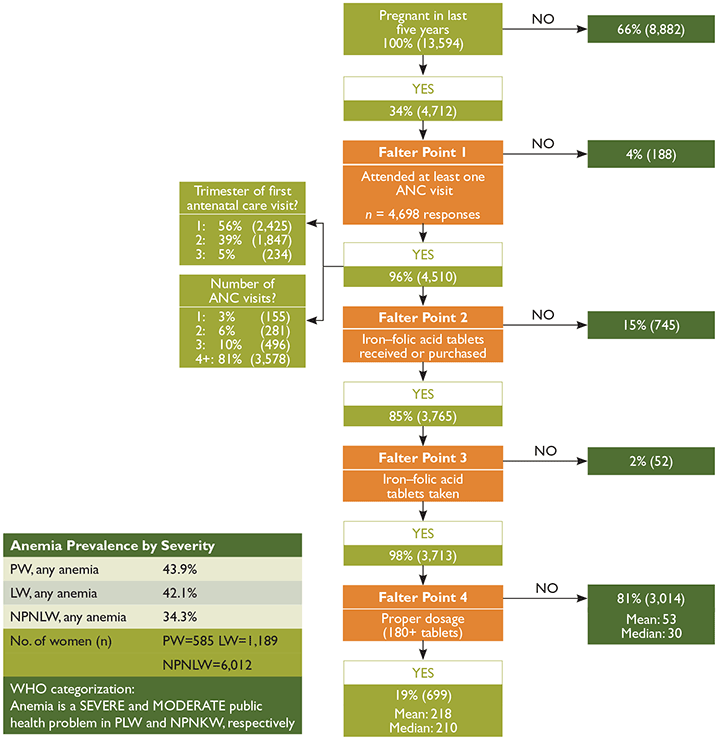
Main Conclusions: ANC coverage is high, providing a strong vehicle for IFA distribution. Among women who were pregnant in the last five years, had at least one ANC visit, and took at least one IFA tablet, only 19 percent received and took the ideal minimum number of tablets. The most important barrier to the distribution of IFA is Falter Point 4, followed by Falter Point 2. Supply and demand considerations are both likely constraints.
Anemia hemoglobin cutoffs: PW Hb<11.0 g/dL; LW, NPNLW Hb<12.0 g/dL
Non-responses, no data (NR/ND) were recoded to “No” for “At least 1 ANC visit?”, “IFA tablets received?” and “IFA tablets taken?” and to zero for “Number of tablets taken?”.
Anemia prevalence data are provided as a reference point, signaling the general order of magnitude of the anemia public health problem. The ANC utilization data is based on self-reported data of women 15–49 years in permanent unions and pertains to their last pregnancy in the last five years prior to the DHS.
Source: Calculations are from the Philippines Demographic and Health Survey (2008). Anemia levels are from WHO VMNIS PW and LW Reference 5242, 2003; NPNLW Reference 2536, 1998.
Many supply-side aspects—including both adequacy of IFA tablet supplies and technical knowledge and practices of ANC providers—need to be considered when assessing how well an ANC program delivers IFA. In addition, Falter Point 4 in Figure 1 clearly shows that the provision of IFA tablets to a pregnant woman is a necessary but not sufficient condition for the woman to consume the tablets, particularly at the ideal minimum. Thus, demand-side factors also play a critical role in determining the coverage and effectiveness of this program. These include whether or not women seek antenatal care and the timing and number of visits, as well as the extent to which women are aware of the significance of anemia and IFA, ask for IFA tablets, and comply with the IFA regimen.
Understanding the relative significance of each falter point enables them to be prioritized for more in-depth analysis, providing a first step in an evidence-based approach to systematically improving the program. The DHS does not collect information on the number of IFA tablets received by women. In the case of Falter Point 4, this lack of data creates ambiguities that make it impossible to fully understand whether shortcomings of the system relate primarily to supply- or to demand-side factors. Despite this limitation, the decision-tree analysis presented in Figure 1 still enables prioritizing the falter points for more in-depth analysis and action at the national, district, and health center levels.
Analysis of Falter Points
Falter Point 1:
Did not attend at least one ANC visit
Only four percent of women did not obtain at least one ANC visit.
ANC’s high coverage provides outstanding potential as a vehicle for achieving high IFA coverage.
Falter Point 2:
Did not receive or purchase at least one IFA tablet
Of the women with at least one ANC visit, 15 percent did not receive or purchase any IFA.
This supply-side constraint may be due to various system/supply-side performance shortcomings which could reflect: (1) Inadequate supply (e.g., stock outs); (2) Provider knowledge; (3) Provider practices that would lead to failure to provide IFA. As Figure 5 shows, this is the second most important falter point among all pregnant women in the Philippines.
Unfortunately, the PDHS does not report the source(s) of the IFA tablets women received or purchased, and there is a small percentage of women attending ANC who get IFA tablets from a different source. While only one percent of Filipino women who received or purchased IFA did not have any ANC visits (not shown), we cannot ascertain whether or not those who received ANC care obtained their IFA from their ANC provider. It is likely, however, that women who attend ANC are more likely to be aware of, to value and to be inclined to also take IFA, regardless of where they obtain them. Thus we would expect there to be a high correlation between the number of women who had at least one ANC visit and those who received or purchased IFA, which is consistent with the data. Women who have one or more ANC visits and who did not receive any IFA constitute a missed opportunity to reduce the risk of anemia among a high-risk population.
Falter Point 3:
Did not take at least one IFA tablet
Of the women who received IFA, two percent did not consume any tablets.
This demand-side constraint is relatively small and may be due to women not understanding the significance of anemia and/or the significance of IFA. This misunderstanding may reflect: (1) inadequate provider counseling and follow-up; (2) women’s beliefs about actual or possible side effects; or (3) sociocultural factors.
Falter Point 4:
Did not consume 180 or more IFA tablets
Of the women who received and took IFA, 81 percent did not consume the ideal minimum of 180 IFA tablets.
This falter point is a combination of supply and demand-side factors. Figure 1 sheds some light on two possible causes of this falter point: 44 percent of women who received ANC began their care after the first trimester, and the 19 percent of women who had less than WHO’s recommended four ANC visits during their last pregnancy may have started their ANC too late or may not have had enough visits to receive 180 tablets (given IFA distribution protocols). Both of these are likely contributing factors, but further research is needed to establish their relative importance, as well as the significance of other possible causes. Globally, research has found that other common causes of Falter Point 4 include: (1) providers do not have access to adequate supply; (2) women do not receive adequate tablets because they have little access to care, start ANC late, or do not have enough ANC visits making it difficult to obtain 180 tablets (given IFA distribution protocols); (3) providers do not provide adequate counseling or follow-up; (4) women do not adhere to the regimen, which may be due to difficulty in remembering to take the tablets daily, not knowing all the tablets are necessary, fear of having a big baby, side effects, or tablet-related issues (taste, size, color, coating, packaging/storage problem). Further research is needed to determine the specific reasons for this falter point in the Philippines.
Analysis by Sociodemographic Variables and Trends over Time
A comparison of 2003 and 2008 PDHS data (Figure 2) reveals that the Philippines improved its already high performing ANC system over this period as measured by coverage, timeliness, amount of care and by two IFA-related indicators. While the percentage of women receiving and taking 90 or more IFA tablets improved by 17 percent, it is important to bear in mind that there is still a long way to go in reaching an acceptable level of adequate IFA tablet distribution, as the cut-off point used here constitutes just half of the ideal minimum number.
Figure 2. Progress in ANC and IFA Indicators in the Philippines, 2003-2008
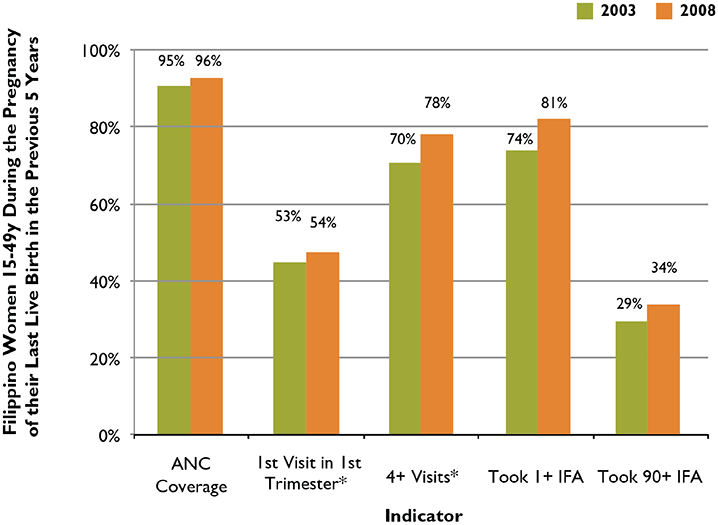
Table 1 provides detailed, region-, residency-, and wealth-specific analyses of ANC and IFA coverage in 2003 and 2008. ANC coverage is high across the Philippines’ 17 regions. While ANC coverage slipped in Eastern Visayas and SOCCSKARGEN in 2008, the falls were minor, with coverage remaining above 93 percent in the two regions. IFA coverage (the percentage of women, among all women who were pregnant in the past five years, who received and took at least one IFA tablet) in the regions are generally 15 to 20 percentage points below their ANC coverage rates, but these gaps narrowed between 2003 and 2008. IFA regional coverage levels —like their ANC levels— are very similar, with the notable exception of ARMM. In both years, ARMM’s levels have been less than half of the national average. Regional measures of the percentage of women who received and took 90 or more IFA tablets during their last pregnancy—in contrast to ANC and IFA coverage measures in recent years—show marked variation in both performance and regional trends. Seven of the 15 regions had declining rates and the percentage of women consuming 90 or more IFA tablets in ARMM in 2008 remained well below the national average. Wealth and residency show a direct relationship to ANC and IFA coverage and the percentage of women who consumed at least 90 IFA tablets. Rates are lower among women in rural areas and in lower wealth quintiles. The gap in ANC and IFA coverage rates by wealth improved slightly over the five year period, but widened in the percentage of women consuming 90 or more IFA tablets.
Table 1. ANC Coverage, IFA Coverage, and 90+ IFA Tablet Consumption in the Philippines among Filipino Women 15–49 Years with a Child Born in the Past Five Years, 2003 and 2008
| Characteristic | ANC Coverage | IFA Coverage | Took 90 + IFA | |||
|---|---|---|---|---|---|---|
| 2003 | 2008 | 2003 | 2008 | 2003 | 2008 | |
| Region | ||||||
| Residence | ||||||
| Wealth | ||||||
| National Capital Region | 95.2% | 95.9% | 76.6% | 87.8% | 30.0% | 43.3% |
| Cordillera Admin Region | 88.9% | 92.9% | 66.5% | 80.7% | 25.4% | 24.1% |
| Ilocos | 92.6% | 93.6% | 77.4% | 79.2% | 30.7% | 37.2% |
| Cagayan Valley | 93.5% | 97.4% | 72.7% | 83.5% | 35.2% | 24.5% |
| Central Luzon | 94.7% | 96.1% | 80.6% | 84.9% | 36.7% | 32.6% |
| CALABARZON | 92.7% | 96.5% | 76.9% | 89.2% | 33.0% | 33.3% |
| MIMAROPA | 90.7% | 95.1% | 73.8% | 76.5% | 16.9% | 13.4% |
| Bicol | 94.2% | 97.2% | 73.3% | 73.5% | 14.0% | 14.6% |
| Western Visayas | 94.9% | 96.3% | 84.7% | 89.7% | 23.7% | 55.5% |
| Central Visayas | 96.2% | 97.7% | 86.9% | 87.7% | 49.9% | 39.4% |
| Eastern Visayas | 97.0% | 95.3% | 74.0% | 77.9% | 17.2% | 30.2% |
| Zamboanga Peninsula | 88.8% | 95.3% | 74.4% | 81.0% | 17.1% | 31.5% |
| Northern Mindanao | 92.0% | 95.0% | 79.7% | 84.2% | 31.8% | 48.3% |
| Davao | 96.2% | 98.8% | 80.2% | 86.6% | 23.3% | 33.4% |
| SOCCSKSARGEN | 94.3% | 93.4% | 76.9% | 79.3% | 30.7% | 27.9% |
| Caraga | 96.3% | 97.8% | 88.8% | 84.8% | 44.7% | 44.2% |
| ARMM | 95.1% | 95.6% | 40.2% | 38.5% | 6.9% | 5.8% |
| Urban | 95.0% | 96.5% | 79.8% | 86.4% | 34.2% | 39.3% |
| Rural | 93.2% | 95.8% | 73.8% | 78.3% | 23.7% | 28.8% |
| Lowest 40% | 91.2% | 93.7% | 63.8% | 73.9% | 18.2% | 23.3% |
| Highest 40% | 97.6% | 98.6% | 82.4% | 91.6% | 43.5% | 49.8% |
| National Average | 94.1% | 96.0% | 76.8% | 82.4% | 29.1% | 34.0% |
Analysis by Geographic Region
The map in Figure 3 shows how the percentage of women with at least one ANC visit who received at least one IFA tablet varies by region. Regional coverage rates vary by a factor or more than two. There appears to be a direct relationship between ANC provision of IFA tablets and the mean number of tablets taken (not shown): regions with a higher percentage of the women with a live birth in the previous five years who reported obtaining IFA tablets and having at least one ANC visit, also had higher average numbers of tablets taken, and vice versa.
Figure 3. Percentage of Women Who Had at Least One ANC Visit and Received at Least One IFA Tablet by Region, Philippines, 2008
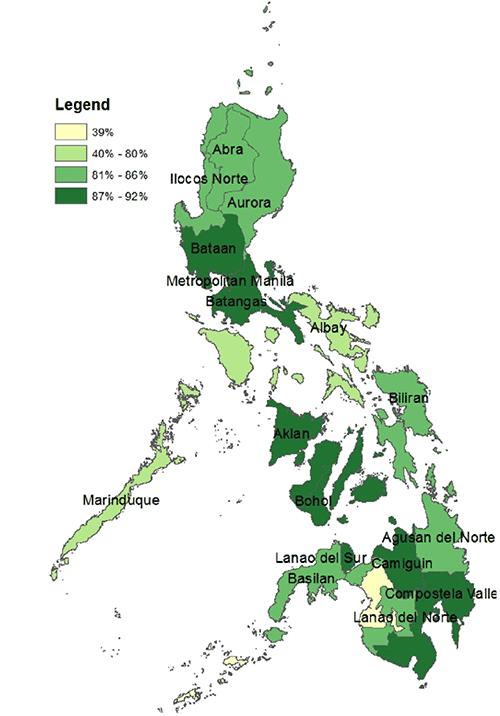
Analysis by Number of ANC Visits
Figure 4 shows the relationship between the number of IFA tablets taken by women who had at least one ANC visit and the number of ANC visits they had during their last pregnancy. Among women who had at least one ANC visit, 56 percent took at most one-quarter (45) of the ideal minimum of 180 IFA tablets. Women with more visits were likely to receive and take more IFA tablets, although the relationship is not strong. Even among those women who received IFA tablets and had four or more visits, 50 percent took at most only one-quarter of the ideal number, and of all women with at least one ANC visit, only 16 percent received and took 180 or more tablets. Still, it should be noted that with 35 percent of Filipino women with one or more ANC visits taking 90 or more IFA tablets, the Philippines’ performance is superior to most other middle- and low-income countries.
Figure 4. ANC Distribution of IFA Tablets: Number of Tablets Received and Taken According to Number of ANC Visits, Philippines, 2008
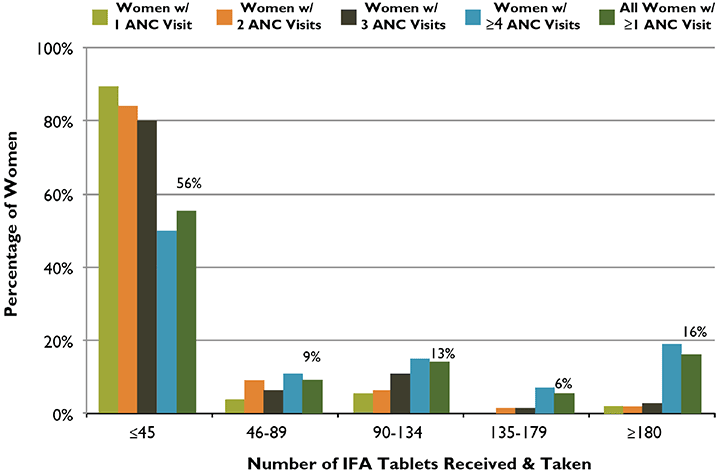
Overall Conclusions and Recommendations
Figure 5 presents the obstacles amongst all women, including those who did not receive ANC during their pregnancy, to taking the ideal minimum number of IFA tablets. In the Philippines, Falter Points 2 and 4 are the greatest barriers. Improving the delivery of IFA supplementation to the Philippines will therefore rely heavily on identifying and addressing program gaps in IFA supply management and health workers’ practices. Modifying some women’s long term adherence behaviors, and addressing other points mentioned above, under “Analysis of Falter Points”, may also lead to more women taking a minimum of 180 tablets (addressing Falter Point 4).
Figure 5. The Relative Importance of Each of the Falter Points in Philippines: Why Women Who Were Pregnant in the Last Five Years Failed to Take the Ideal Minimum of 180 IFA Tablets
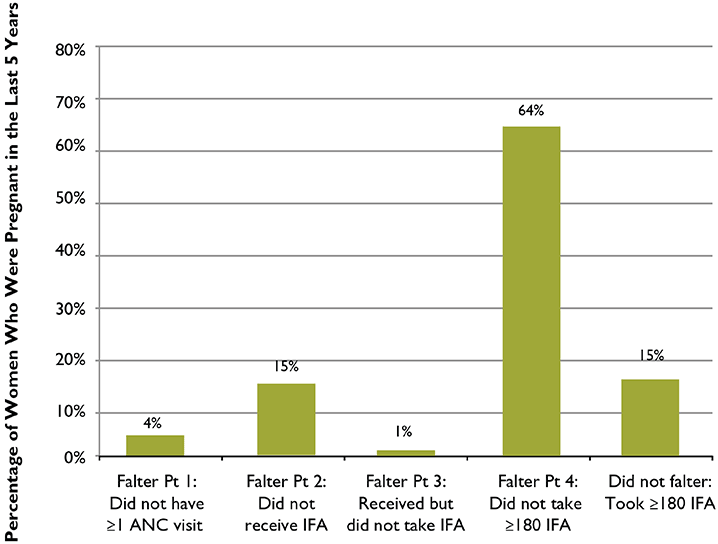
Between 2005 and 2010, the Philippines decreased its maternal mortality rate (MMR) from 110 maternal deaths per 100,000 live births to 99. The pace of improvement, however, was slower than that of other countries with similar 2005 levels resulting in the Philippines’ MMR ranking slipping from 116 (out of 181 countries) to 118 (WHO 2012b). Moreover, it looks unlikely that the Philippines will achieve its fifth Millennium Development Goal (MDG5) to improve maternal health, and reach an MMR of 52. To accelerate its progress toward achieving that target, the Philippines should conduct formative research to identify and prioritize obstacles realizing the full potential of its ANC-based IFA distribution efforts, especially in the ARMM and other low-performing regions.
This rapid assessment of the distribution of IFA tablets through ANC in the Philippines suggests that there is substantial room for improvement in the supply- and also demand-sides of the program. Improving the distribution of IFA through the ANC program is an important strategy to prevent and control anemia in the Philippines, and to improve the nutrition and health status, as well as the mental and physical capacity of women of reproductive age.
Footnotes
1 The WHO categorizes the severity of anemia as a public health problem according to its prevalence: <5%, no public health problem; 5–19.9%, mild; 20–39.9% moderate; ≥40%, severe.
2 The PDHS asked about IFA tablets or capsules; this brief refers to all types as “tablets.”
3 The PDHS provides a population-based, nationally representative sample of all women in the Philippines.
References
Cheong, R. L., J. R. Madriaga, L. A. Perlas, J. A. Desnacido, J. M. Marcos, and M. I. Z. Cabrera. 2001. “Prevalence of anemia among Filipinos.” Philippine Journal of Nutrition 49(1-2): 45-57.
de Jong, Nynke, Aurora B. Ampong Romano, and Roaslind S. Gibson. 2002. “Zinc and Iron Status During Pregnancy of Filipino Women.” Asia Pacific Journal of Clinical Nutrition 11(3): 186-193.
Department of Health, Office of the Secretary (Republic of Philippines), 2000. Administrative Order No. 3A s. 2000: Guidelines on Vitamin A and Iron Supplementation.
Food and Nutrition Research Institute (FNRI) Philippines. 2004. The Sixth National Survey 2003. Manila: FNRI.
Galloway, Rae. 2003. Anemia Prevention and Control: What Works. Washington, DC: USAID.
Horton, Sue and Jay Ross. 2003. “The Economics of Iron Deficiency.” Food Policy 28(1):51-75.
National Statistics Office (NSO) [Philippines], and ORC Macro. 2004. National Demographic and Health Survey 2003. Calverton, Maryland: National Statistics Office and ORC Macro.
NSO [Philippines], and ICF Macro. 2009. National Demographic and Health Survey 2008. Calverton, Maryland: National Statistics Office and ICF Macro.
Stoltzfus, Rebecca J., and Michele L. Dreyfuss. 1998. Guidelines for the use of Iron Supplements to Prevent and Treat Iron Deficiency Anemia. Washington DC: ILSI Press.
Stoltzfus, Rebecca J., Luke Mullany, and Robert E. Black. 2004. “Iron Deficiency Anemia.” In Comparative Quantification of Health Risks: Global and Regional Burden of Disease Attributable to Selected Major Risk Factors, edited by Majid Ezzati, Alan D. Lopez, Anthony Rodgers, and Christopher J. L. Murray, 163-209. Geneva, Switzerland: World Health Organization.
World Health Organization (WHO). 2012a. “Guideline: Daily Iron and Folic Acid Supplementation in Pregnant Women.” Geneva: WHO.
WHO. 2012b. Indicator and Measurement Registry version 1.6.0. Maternity mortality rate. [August 28, 2012].